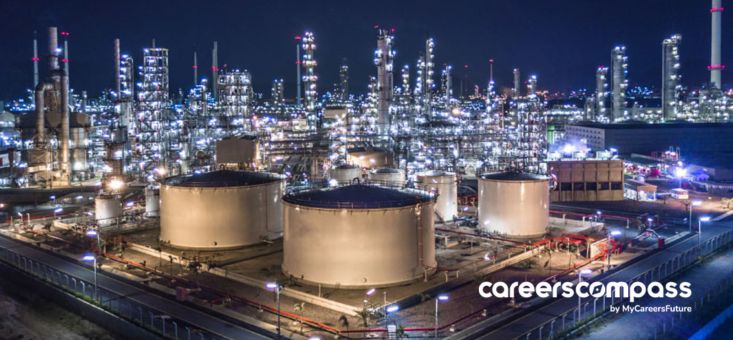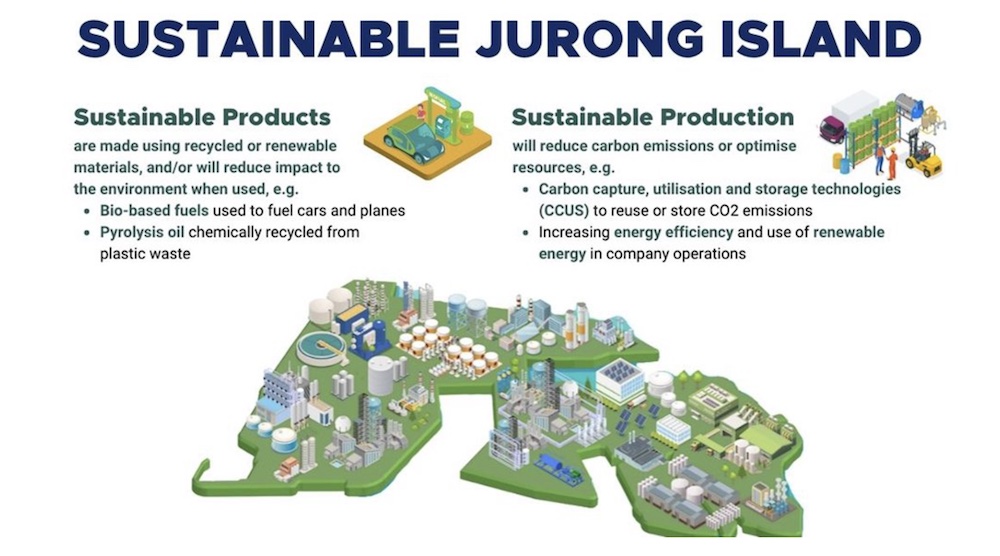Questions about the energy and chemicals sector answered
- What is Singapore’s energy and chemicals sector?
- Is the energy and chemicals sector stable if you’re considering a mid-career switch?
- What kind of jobs are there in the energy and chemicals sector?
- What’s the salary like?
- What are the growth areas in the energy and chemicals sector?
- What courses or skills are needed to join the energy and chemicals sector?
About Singapore’s energy and chemicals sector
The energy and chemicals sector has significantly influenced Singapore’s economic growth since the 1960s. Although Singapore is not an oil-producing country, it has become a significant player.
Jurong Island is a hub for refining, petrochemical, and speciality chemicals activities. The integrated infrastructure on Jurong Island creates production synergies and cost-saving measures for companies operating in the sector. Today, the island houses over 100 energy, petrochemical, and speciality chemicals companies, including global companies such as Shell, ExxonMobil, BP, and Chevron.
Size of the market
The energy and chemicals sector employed more than 27,000 people in 2020, contributing around 3% of Singapore’s gross domestic product (GDP) and one-fifth of the country’s total manufacturing output.

Find your next job on MyCareersFuture. We have over 100,000 job opportunities daily for you.
Why is this sector important to Singapore’s economy?
Singapore’s strategic location, robust infrastructure, and supportive government policies have positioned it as a critical player in the global energy and chemicals market. The sector’s importance is further underscored by its substantial contributions to GDP and employment. Moreover, the presence of major multinational companies on Jurong Island underscores the sector’s significance in attracting foreign direct investment, fostering innovation, and driving economic growth.
Growth areas and outlook of the energy and chemicals sector
As the world moves toward cleaner energy sources and embraces more sustainable practices, there may be reduced demand for traditional petrochemical products, such as plastics and synthetic chemicals derived from fossil fuels.
This could impact Singapore’s petrochemical manufacturing industry, which is a significant player in the global market.
To adapt to the changing landscape, the Singapore government has proactively supported the energy and chemicals sector by implementing policies and initiatives to promote the sector’s growth and development, including tax incentives, funding support, and infrastructure development.
Industry Transformation Map
Anticipating these shifts in the evolution of the energy and chemicals sector, the Singapore government launched the Energy & Chemicals Industry Transformation Map (ITM) 2025, a key strategy aimed at decarbonising the sector while seizing new growth opportunities.
The roadmap is a two-pronged strategy expected to generate $12.7 billion in value-add and 1,400 new jobs by 2025. As it shifts its focus to high-value and speciality chemicals, the ITM will prioritise four clusters in speciality chemicals: nutrition and agriculture, cleanliness and health, smart materials and mobility, and sustainability.
This includes plans to transform the existing base of chemical manufacturing through the adoption of innovative technologies.
Jurong Island Transformation
The government has initiated the transformation of Jurong Island in Singapore into a sustainable energy and chemicals park. This will support decarbonisation efforts while helping energy and chemicals companies transition to sustainable practices.
(Image credit: EDB Singapore)
This transformation involves implementing various initiatives and strategies to promote the adoption of decarbonisation and sustainability solutions. One key initiative is the Resource Efficiency Grant for Energy, which supports companies in adopting these solutions.
This transformation involves implementing various initiatives and strategies to promote the adoption of decarbonisation and sustainability solutions. One key initiative is the Resource Efficiency Grant for Energy, which supports companies in adopting these solutions.
Mid-career switch: Why is the energy and chemicals sector a good choice?
The evolving landscape of the energy and chemicals sector offers numerous opportunities for mid-career professionals. With the sector’s focus shifting towards renewable energy, clean technologies, and sustainable practices, there is a growing demand for professionals with expertise in these areas.
This shift provides job security and aligns with global trends towards sustainability, making it an attractive option for those looking to make a meaningful impact while advancing their careers.
What are the types of jobs, and what is the salary like in the energy and chemicals sector?
The energy and chemicals sector offers various job opportunities, from chemical engineers and lab technicians to sustainability specialists and project managers. Salaries in this sector are generally competitive, reflecting the sector’s significant economic contribution. Here are some examples of job roles in the sector listed in MyCareersFuture jobs portal for your information:
| Role | Salary Range |
| Process Engineer | $3,000 to $4,500 |
| Laboratory Technologist | $2,500 to $3,000 |
| Safety Engineer | $4,000 to $5,000 |
| Sustainable Energy Executive | $6,000 to $7,500 |
| Project Manager | $6,000 to $7,000 |
| Renewable Energy Engineer | $4,500 to $7,500 |
| Performance Engineer | $6,000 to $9,200 |
| Environmental Engineer | $5,000 to $6,500 |
| Sales Engineer | $3,500 to $4,200 |
| Maintenance Scheduler | $6,000 to $8,000 |
What courses or skills are needed to join the energy and chemicals sector?
To enter the energy and chemicals sector, individuals need to possess a strong foundation in chemical engineering and related disciplines. Continuous upskilling through relevant courses and certifications is essential for career advancement.
Jobseekers or mid-career switchers who are keen on joining the energy and chemicals sector can get support and On-the-Job Training by signing up for the following Career Conversion Programmes by Workforce Singapore:
- CCP for Future Energy & Chemicals Sector (New Hires PMET)
- CCP for Future Energy & Chemicals Sector (New Hires RnF)
Additionally, as the sector moves towards sustainability, skills in renewable energy, clean technologies, and environmental management are increasingly valuable. Jobseekers or mid-career switchers can also join the energy and chemicals sector for roles in carbon management by signing up for the following Career Conversion Programmes:
Here are some useful readings to help you learn more.
What’s it Like to Work as a Chemical Engineer?
How to Prepare for a Lucrative Career in Advanced Manufacturing
Top 3 Reasons Why You Should Take Up a Lab Technician Job
















